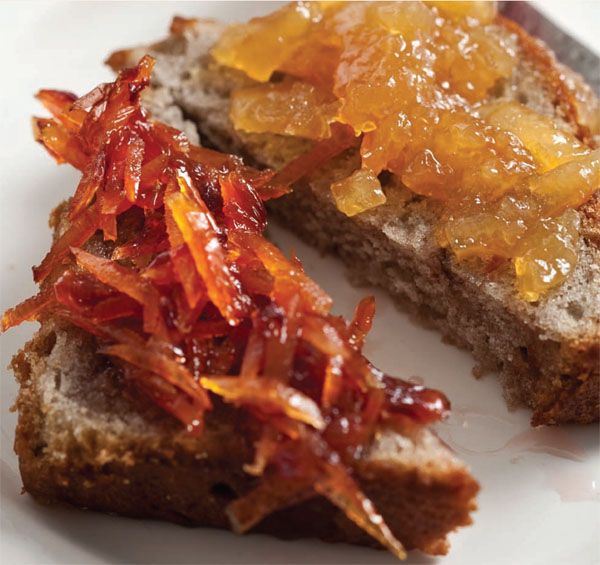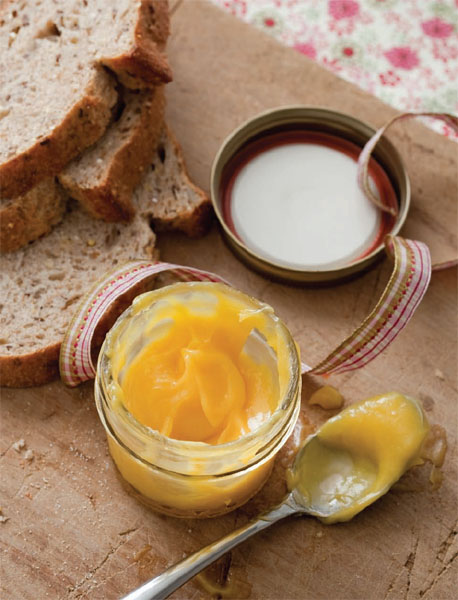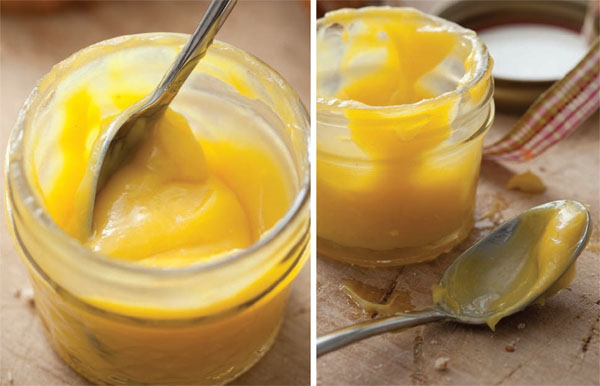Food in Jars (14 page)
Authors: Marisa McClellan

When the marmalade reaches 220°F/105°C and sustains that temperature for 1 minute (even after stirring), remove the pot from the heat. Test the set of the marmalade
using the saucer test described on page 77. If it doesn't pass, return the pot to the heat and cook for an additional 5 minutes before repeating the test. Once it seems to be setting to your satisfaction, remove the pot from the heat and stir for about 1 minute, to help the zest bits become evenly distributed throughout the preserve.
Ladle the marmalade into the prepared jars. Wipe the rims, apply the lids and rings, and process in a boiling water bath for 10 minutes (see
page 11
).

Blood Orange Marmalade, Meyer Lemon Marmalade


M
OST PEOPLE THINK THAT CITRUS CURDS BELONG
to the world of high teas and clotted cream. However, if you've never tasted freshly cooked curd, you're missing out on one of the more delicious moments in life. It has an impossibly smooth texture that is set off by the pucker of the citrus.
When you make a batch of citrus curd, make sure that you use the best eggs and butter you can afford. I like to search out free-range eggs that have naturally bright orange yolks, as their color will help to enhance the vivid hue of the finished curd. It should be as sunny as possible.
You'll notice that these curd recipes makes just a single pint (500 ml). Because this isn't a preserve that needs to boil for an extended period to reduce, as long as you have a large enough double boiler, you can double and even triple the recipe. However, do note that when canning this one, it is recommended that you opt for either 4- or 8-ounce (125 or 250 ml) jars. The smaller jars allow the heat to penetrate fully throughout the jars during processing and ensure a safer final product. What's more, you shouldn't make more than you can eat or give away in the span of a couple months; these have a shelf life of no more than 3 to 4 months.
Conserves are on the other side of the preserve spectrum from curds. They are jams that have been enriched by the addition of dried fruit, nuts, coconut, or liquors. They tend to be a bit less sweet than your average jam and have a more varied texture, thanks to the addition of the bits of nuts or dried fruit spread throughout.
I find that conserves make excellent gifts, because they are different from the standard preserves that are easily bought at grocery stores and gourmet markets.

T
HE FIRST TIME I TASTED LEMON CURD, I FELL HARD.
I was eleven years old and my family had received a jar of homemade lemon curd from some California cousins. They kept chickens in their backyard with lemon trees out front, and so made jars of curd using these homegrown ingredients to send to friends and family for the holidays. I ate the bulk of that jar in stealthy spoonfuls.
¼ cup/80 g finely grated Meyer lemon zest (about 4 medium Meyer lemons)
1¼ cups/250 g granulated sugar
4 large egg yolks
2 large eggs
½ cup/120 ml Meyer lemon juice
6 tablespoons/85 g cold unsalted butter, cut into cubes
Prepare a boiling water bath and 2 half-pint/250 ml jars according to the process on page 10. Place the lids in a small saucepan, cover them with water, and simmer over very low heat.
Combine the lemon zest and sugar in a small bowl. Rub the zest into the sugar until it is fragrant and fully combined. Set aside.
Set up a double boiler, add 2 inches/5 cm of water to the bottom pan and bring to a simmer over medium heat. Alternatively, set a heatproof mixing bowl over a medium saucepan filled with 2 inches/5 cm of water, making sure the bottom of the bowl does not touch the surface of the water. Keeping the top half of the double boiler off the stove, combine the egg yolks and whole eggs and whisk them together. Add the zest and sugar combination and whisk in. Finally, add the lemon juice and stir until it is blended.
Add the butter and set the top of the double boiler over the simmering water. Switch to a silicone spatula and stir continually as the lemon curd cooks.
Using a candy thermometer, monitor the temperature of the curd while you stir. As it approaches 190° to 200°F/90° to 95°C, it should start to thicken. One sign of
doneness is that it will coat the back of your spatula without running or dripping.
If it is slow to thicken but is approaching 210°F/100°C, remove the top portion of the double boiler and let it cool for a moment before returning to the heat for an additional minute or two of cooking. It typically takes 6 to 9 minutes for a curd to cook through.
When the curd has thickened to the consistency of sour cream, it is done. Remove the top half of the double boiler and stir off the heat. During this time, it will continue to thicken a bit.
Strain the curd through a fine-mesh sieve into a 4-cup/960 ml measure. The straining removes both the zest (which will have imparted a great deal of flavor to the curd during cooking time) and any bits of scrambled egg.
Pour the curd into the prepared jars, leaving a generous ½ inch/12 mm of headspace. Wipe the rims, apply the lids and rings, and process in a boiling water bath for 25 minutes (see
page 11
).
When the time is up, remove the canning pot from the heat and remove the lid. Let the jars sit in the pot for an additional 5 minutes. This helps to prevent the curd from reacting to the rapid temperature change and bubbling out of the jars.

Meyer Lemon Curd

I
CONSIDER THIS LIME CURD THE CHEAPEST VACATION
possible. For just a few dollars in ingredients and less than an hour of active work, I have a finished product that makes me feel transported to someplace tropical. Truly, after just a few tastes, the air seems to get warmer and I swear I can feel the grit of sand under my feet. Even if you don't need a beach escape, this curd is worth trying. I like to stir it into yogurt, but if you're searching for a more elegant application, try spreading it in a baked tart shell for a quick dessert. Top the tart with a ring of fresh raspberries if you really need to impress.
¼ cup/80 g finely grated lime zest (from about 4 limes)
1¼ cups/250 g granulated sugar
4 large egg yolks
2 large eggs
½ cup/120 ml freshly squeezed lime juice (from about 6 limes)
6 tablespoons/85 g cold unsalted butter, cut into cubes
Prepare a boiling water bath and 2 half-pint/250 ml jars according to the process on page 10. Place the lids in a small saucepan, cover them with water, and simmer over very low heat.
Combine the lime zest and sugar in a small bowl. Rub the zest into the sugar until it is fragrant and fully combined. Set aside.
Set up a double boiler, add 2 inches/5 cm of water to the bottom pan and bring to a simmer over medium heat. Alternatively, set a heatproof mixing bowl over a medium saucepan filled with 2 inches/5 cm of water, making sure the bottom of the bowl does not touch the surface of the water. Keeping the top half of the double boiler off the stove, add the egg yolks and whole eggs to it and whisk them together. Add the zest and sugar combination and whisk in. Finally, add the lime juice and stir until blended.
